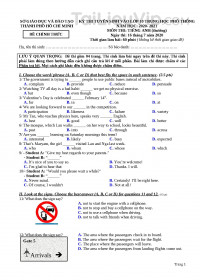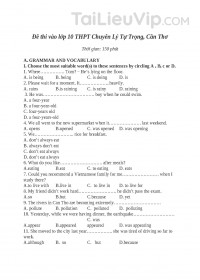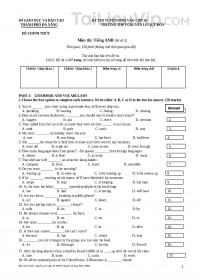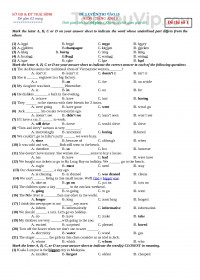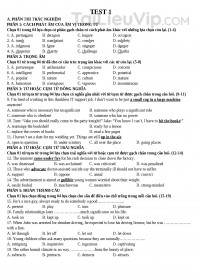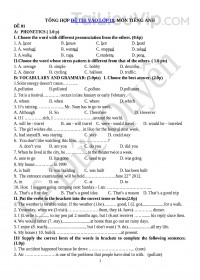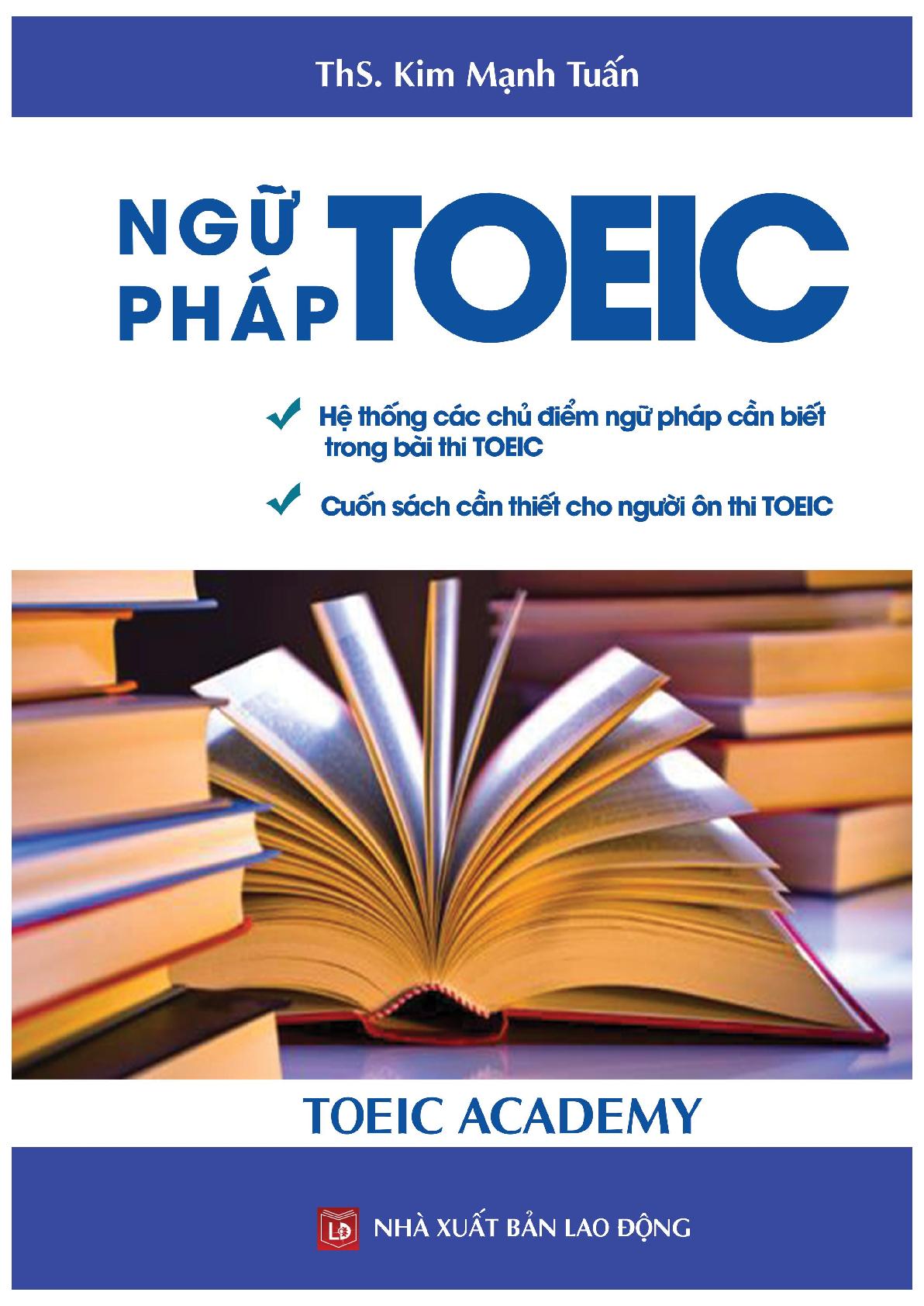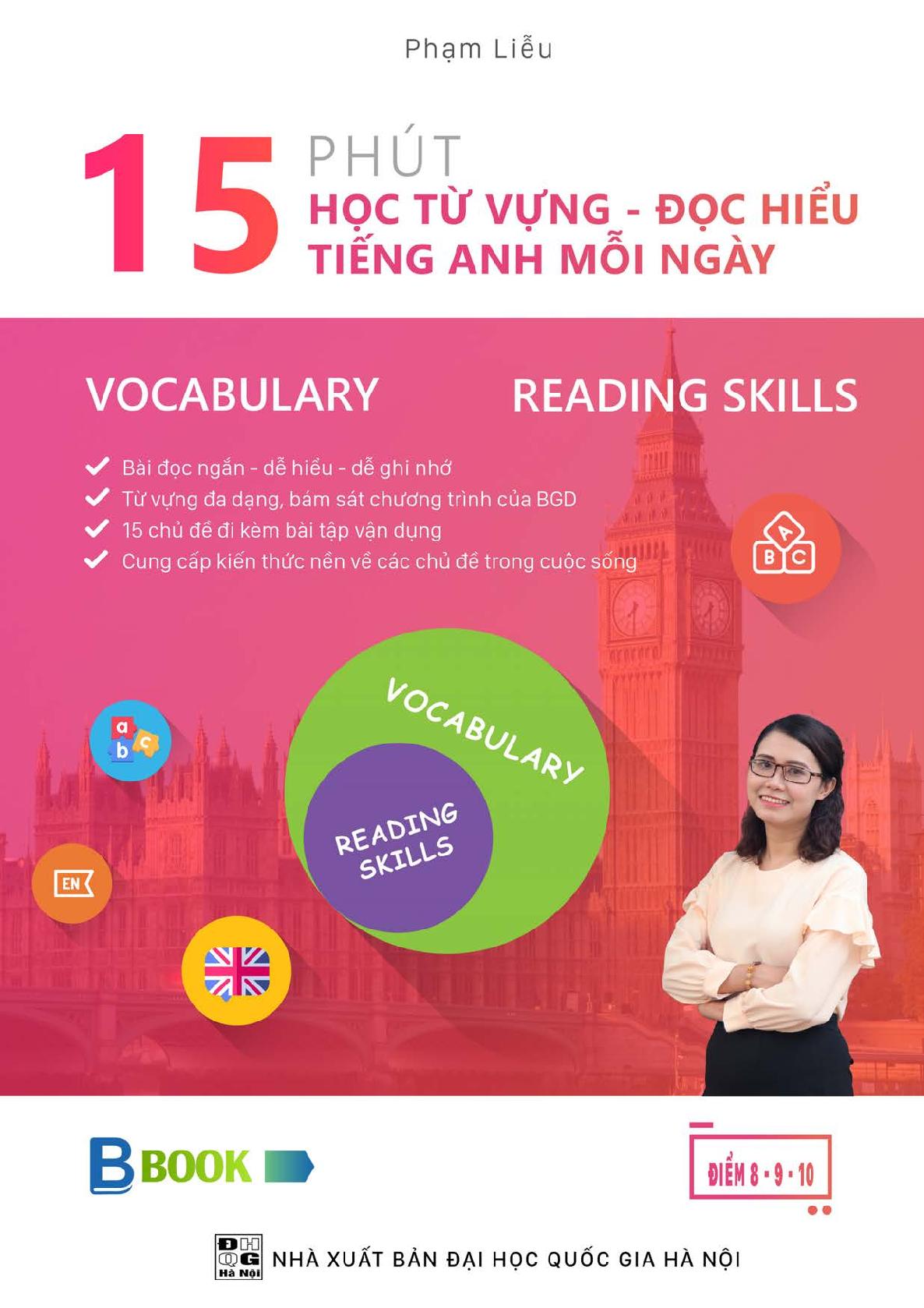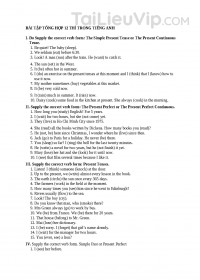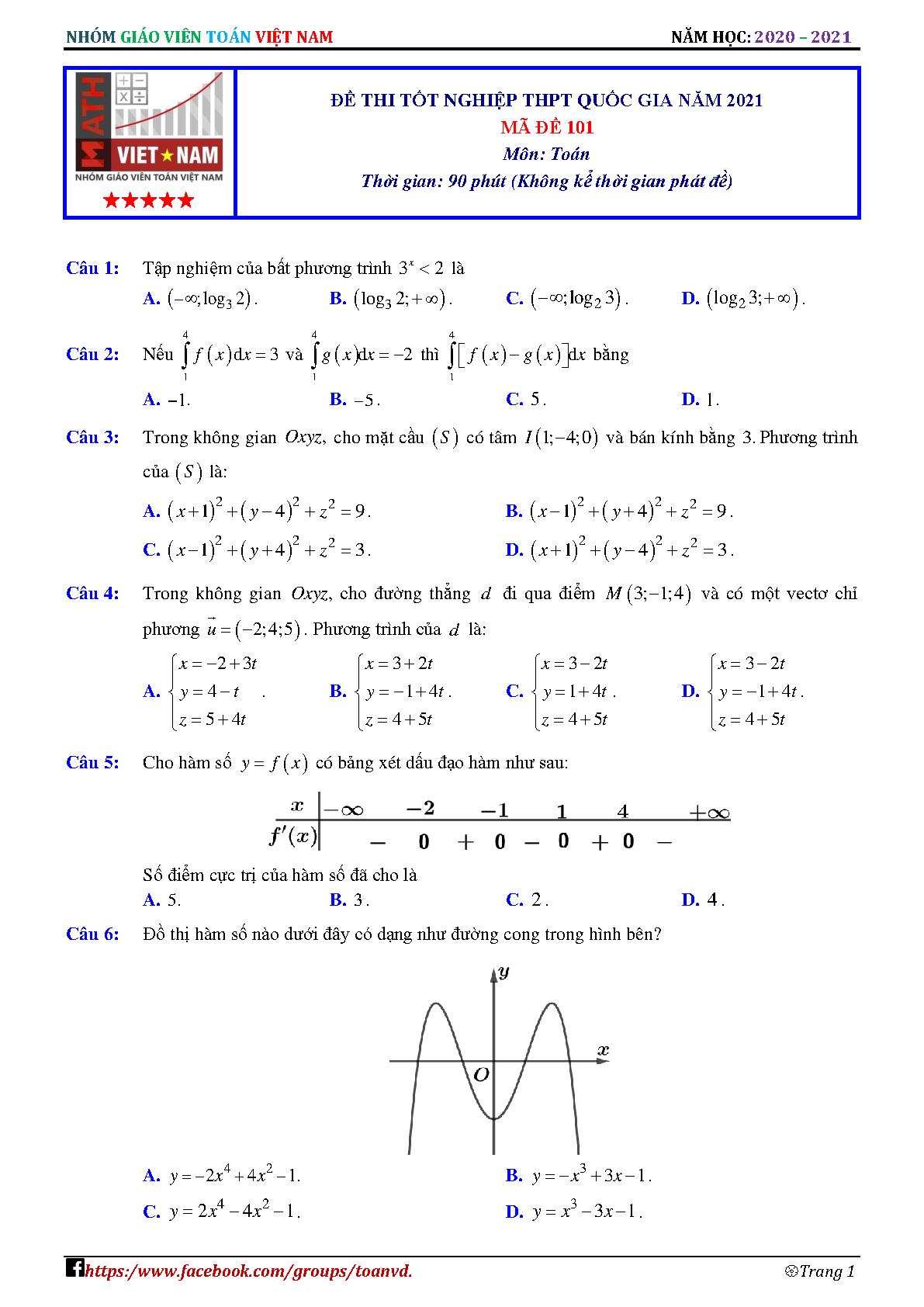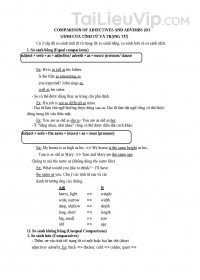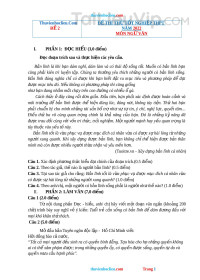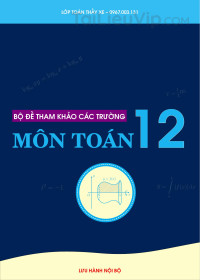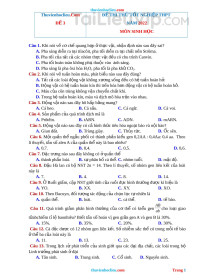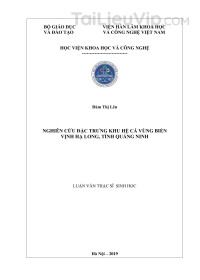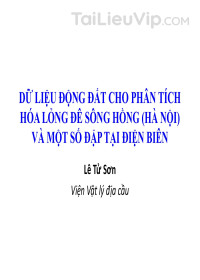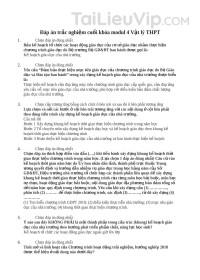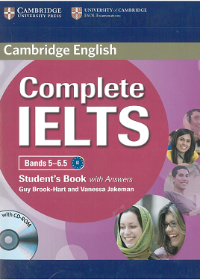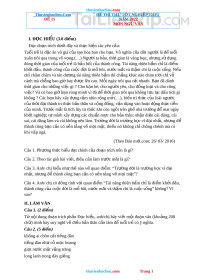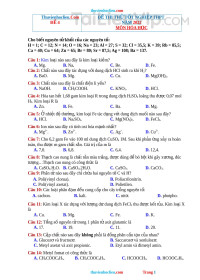Đề Thi THPT Chuyên Môn Tiếng Anh
1,459 12

Tải về máy để xem đầy đủ hơn, bản xem trước là bản PDF
Tags: #Đề thi THPT CHuyên môn tiếng anh#đề thi vào 10 môn tiếng anh#bộ đề ôn tập môn tiếng anh ôn vào 10
Mô tả chi tiết
MOCK TEST NO 1
A. TRẮC NGHIỆM
Phần 1. Cách phát âm của âm vị trong từ
Chọn 01 trong 04 lựa chọn có phần gạch chân có cách phát âm khác với những từ còn lại.
1. A. confusedlyB. wickedlyC. allegedlyD. supposedly
2. A. monthsB. mouthsC. wreathsD. youths
3. A. forwardB. stewardC. cowardD. award
4. A. delicateB. concentrateC. privateD. accurate
5. A. favourB. flavourC. savourD. devour
Phần 2. Trọng âm
A. TRẮC NGHIỆM
Phần 1. Cách phát âm của âm vị trong từ
Chọn 01 trong 04 lựa chọn có phần gạch chân có cách phát âm khác với những từ còn lại.
1. A. confusedlyB. wickedlyC. allegedlyD. supposedly
2. A. monthsB. mouthsC. wreathsD. youths
3. A. forwardB. stewardC. cowardD. award
4. A. delicateB. concentrateC. privateD. accurate
5. A. favourB. flavourC. savourD. devour
Phần 2. Trọng âm

Nội dung
PH Ầ N ICẤU TRÚC ĐỀ THI VÀ0 10 CHUYÊN NGOẠI NGỮMÔN THI: ĐÁNH GIÁ NĂNG LỰC NGOẠI NGỮ TIẾNG ANHThời gian làm bài: 120 phútS ố phần thi: 2Tổng số câu hỏi: 80 câu hỏi trắc nghiệm 4 lựa chọn + 1 phần viết tự luận gồm 1 câu hỏiHình thức làm bài: Viết trên giấy Phần thi Bài thi Mô tả câu hỏi Yêu cầu đối với thí sinh Số câu hỏi Kiến thức, kỹ năng được đánh giáPhần thi trắc nghiệm Cách phát âmcủa âm vị trong từ Mỗi câu hỏi gồm 04 lựa chọn A, B, C, D. Mỗi lựa chọn là một từ có 1 phần đượcgạch chân. 03 lựa chọn có phần gạch chân có cách phát âm giống nhau và 01 lựa chọn có phần gạch chân có cách phát âm khác với những lựa chọn còn lại. Chọn 01 trong 04 lựa chọn có phần gạch chân có cách phát âm khác với những lựa chọn còn lại. 05 Khả năng xác định cách phát âm hoặc trườngđộ của các âm vị nguyên âm hoặc phụ âm trong từ tiếng Anh.Trọng âm củatừ Mỗi câu hỏi gồm 04 lựa chọn A, B, C, D. Mỗi lựa chọn là 01 từ. 03 lựa chọn có vị trí trọng âm giống nhau và 01 lựa chọn còn lại có vị trítrọng âm khác với những lựa Chọn 01 từ trong 04 từ đã cho có vị trí trọng âm khác với các từ còn lại. 05 Khả năng xác định trọng âm (chính và phụ) trong đơn vị từ tiếng Anh.chọn khác.Tìm từ/cụm từ đồng nghĩa Mỗi câu hỏi gồm 01 câu với 01 từ hoặc cụm từ được gạch chân. Tương ứng vớiphần gạch chân là 04 lựa chọn A, B, C, D trong đó 01 lựa chọn đồng nghĩa với từ/cụm từ đượcgạch chân. Chọn 01 từ hoặc cụm từ trong 04 lựa chọn đồng nghĩa với từ/cụm từ đượcgạch chân trong câu hỏi. 03 Khả năng hiểu nghĩa và xác định từ/cụm từ đồng nghĩa trong tiếng AnhTìm từ/cụm từ trái nghĩa Mỗi câu hỏi gồm 01 câu với 01 từ hoặc cụm từ được gạch chân. Tương ứng vớiphần gạch chân là 04 lựa chọn A, B,? C, D trong đó 01 lựa chọn trái nghĩa với từ/cụm từ đượcgạch chân. Chọn 01 từ hoặc cụm từ trong 04 lựa chọn trái nghĩavới từ/cụm từ được gạch chân trong câu hỏi. 03 Khả năng hiểu nghĩa và xác định từ/cụm từ trái nghĩa trongtiếng AnhTìm lỗi sai Mỗi câu hỏi gồm 01 câu với 04 từ/cụm từ được gạch chân theo thứ tự ký hiệu A, B, C và D. Trong 04 phần được gạch chân có 01 phần gạch chân có chứa Chọn 01phần gạchchân trong 04 lựa chọn có chứa lỗi sai. 06 Khả nãng xác định lỗi sai trong câutiếng Anh.lỗi sai.Hoàn thành câu Mỗi câu hỏi gồm 01 câu với 01 chỗ trống. Tương ứng với chỗ trống là 04 lựa chọn A, B, C, D để hoàn câu. Chọn 01 từ hoặc cụm từ trong 04 lựa chọn để hoàn thành câu. 10 Khả năng hiểu nghĩa và xác định chức năngcủa từ/cụm từ trong câu.Điền từ 01 đoạn văn cóđộ dài từ 200- 300 từ với 08 chỗ trống đượcđánh số theo thứ tự. Dưới đoạn văn có 8 câu hỏi tương ứng với các chỗ trống đó. Mỗi câu hòi có04 lựa chọn A, B, C, D là các từ hoặc cụm từcó thể điền vàocác chỗ trống. Chọn 01 lựa chọn đúng trong 04 lụa chọn cho sẵn đê điền vào chỗ trống trongđoạn văn. 08 Kiến thức về từvựng, ngữ pháptrong mệnh đề, câu và diễn ngôn tiếng Anh.Bài đọc 1 01 bài đọc có độ dài khoảng 250- 400 từ. Dưới bài đọc có 8 câu hỏi đánh số theo thứ tự. Mỗi câuhỏi bao gồm 04 lựa chọn A, B, C, D. Đọc đoạn văn và frả lời 8 câuhỏi kèm theo. 08 Khả năng dọc v ă n bản tiếng Anh lấy ý chính, xác địnhcấu trúc, hiểu mục đích, thái độ, quan điểm của tác giả, hiểu thông tin chi tiết, nghĩa của từ và cụm từ, tham chiếu, hàm ng ô n, suy diễn qua ngữ cảnh.Bài đọc 2 01 bài đọc có Đọc đoạn văn 08 Khả năng đọcđộ dài khoảng 250- 400 từ. Dưới bài đọc có 8 câu hỏi đánh số theo thứ tự. Mỗi câuhỏi bao gồm 04 lựa chọn A, B, C, D. và trả lời 8 câuhỏi kèm theo. v ă n bản tiếng Anh lấy ý chính, xác địnhcấu trúc, hi ể u mục đích, thái độ, quan điểm của tác giả, hiểu thông tin chi tiết, nghĩa của từ và cụm từ, tham chiếu, hàm ngôn, suy diễn qua ngữ cảnh.Hoàn thành hội thoại Mỗi câu hỏi gồm 01 hội thoại có 02 lượt lời (01 lời nói và 01 lời đáp), trong đó lời nói hoặc lờiđáp có 01 chỗ trống. Dưới hộithoại có 04 lựa chọn A, B, C , D là các cụm từ hoặc câu có độ dài tưong tựnhau. 01 trong 04 lựa chọn có thể điền vào chỗ trống. Chọn 01 lựa chọn đúng ở mỗi câu hỏi để điền vào chỗ trống. 05 Kiến thức và khả năng hiểu nghĩa và sử dụng ngôn ngữphù hợp vời hoàn cành giao tiếp; Kiến thức và khả năng sử dụng những cặp thoại liền kề (adjacency pairs) phổ biến.S ắp xếp h ộ i tho ạ i Mỗi câu hỏi gồm 01 đoạn hội thoại có 4-6 lượt lời bị xáo trộn thứ tự và được đánh dấu bằng chữ cái in thường a, b, c, d, e, f. Chọn 01 lựa chọn là trật tự đúng của các lượt lời trong hội thoại đã cho. 05 Kiến thức và khả năng hiểu nghĩa và sử dụng ngôn ngữ giao tiếp phù hợp với ngữ cành giao tiếp; Khả năng hiểu suy diễn vàDưới hội thoại có 04 lựa chọn A, B, C, D là các cách sắp xếp các lượt lời theo trật tự khác nhau. 01 trong 04 lựa chọn là trật tự đúng của các lượt lời trong hội thoại đã cho. hàm ngôn phù hợp với ngữ cảnh giao tiếp.Viết lại câu Mỗi câu hỏi gồm 01 câu hoặc cặp câu tiếng Anh đi kèm với 04 lựachọn A, B, C, D là các cách diễn đạt khác nhau có liên quan đến câu hoặc cặp câu đó. 01 trong 04lựa chọn đồng nghĩa hoăc cậnnghĩa nhất với câu hoặc cặp câu đã cho. Chọn câu đồngnghĩa hoặc cậnnghĩa nhất với câu hoặc cặp câu đã cho trong câu hỏi. 05 Khả năng xác định câu đồng nghĩa hoặc cận nghĩa.Kết hợp câu Mỗi câu hỏi gồm 01 cặp câu tiếng Anh đi kèm với 04 lựa chọn A, B, C, D là các cách diễn đạt khác nhau có liên quan đến cặp câu đó. 01 trong 04 lựa Chọn câu đồngnghĩa hoặc cậnnghĩa nhất với cặp câu đã cho trong câu hỏi. 05 Khả năng hiểu nghĩa các câu đơn lẻ và mối liên hệ ngữ nghĩa giữachúng; và khả năng kết hợp các câu đơn lẻ sử dụng cấu trúc câu phức và các liên từchọn đồng nghĩa hoặc cậnnghĩa nhất với cặp câu đã cho. phù hợp.Hoàn thành bài luận Một đoạn vãn gồm 200-250 từ có 4 cụm từ hoặc câu bị bỏ trống và được đánh so theo thứ tự. Dưới bài luận có 04 câu hỏi tương ứng với các chỗ trống. Mỗicâu hỏi gồm 04lựa chọn A, B, C, D là 01 cụmtừ hoặc câu. 01trong 04 lựa chọn có thể điền vào chỗ trống. Chọn 01 cụm từ hoặc câu trong 04 lựa chọn cho sẵn trong mỗicâu hỏi để điềnvào chỗ trống tương ứng trong bài luận đã cho. 04 Khả năng hiểu nghĩa diễn ngôn hoặc vàn bản tiếng Anh; Kiến thức về cách phát triển ý trong một văn bản tiếng Anh.Phần thi tự luận Viết văn bản Một chù đề cho sẵn có liênquan đến chương trình giảng dạy Tiếng Anh Trung học cơ sở. Viết một vănbản khoảng 250 từ về một chủ đề cho sẵn. 01 Khả năng viết sản sinh một văn bản tiếng Anh trình bày một ý kiến hay thông tin trọn vẹn.MOCK TEST NO 1A. TR Ắ C NGHIỆM Phần 1. Cách phát âm của âm vị trong từChọn 01 trong 04 lựa chọn có phần gạch chân có cách phát â m khác v ới những từ còn lại.1. A. confus ed ly B. wick ed ly C. alleg ed ly D. suppos ed ly2. A. mon th s B. mou th s C. wrea th s D. you th s3. A. forwa rd B. stewa rd C. cowa rd D. awa rd4. A. delic a te B. concentr a te C. priv a te D. accur a te5. A. fav our B. flav our C. sav our D. dev ourPhần 2. Trọng âm20 đề thi vào 10 Chuyên Ngoại Ngữ của Phạm thị Mai Hương, tài liệu dài 170 trang có key, vui lòng liên hệ Z alo 0988166193 để có tài liệu Chọn 01 trong 04 lựa chọn có cấu trúc trọng â m khác với những từ còn lại.6. A. tournament B. continent C. physician D. heritage7. A. philosophy B. engineering C. adaptation D. influential8. A. economy B. political C. believable D. architecture9. A. common B. begin C. require D. around10. A. argumentative B. psychological C. hypersensitive D. contributoryPhần 3. Từ hoặc cụm từ đồng nghĩaChọn 01 từ/cụm từ trong 04 lựa chọn có nghĩa gần nhất với từ/cụm từ được gạch chân .11. All the student of that faculty are disaffected with their professor’s inequitable behavior.A. discouraged B. discontented C. disqualified D. disabused12. These shoes are made of imitation leather.A. natural B. man-made C. valuable D. expensive 13. The naughty boy wax scolded yesterday for hil indisciplinable behaviors in the family farewell partyA. told off B. complimented C. punished D. beatenPhần 4. Từ hoặc cụm từ trái nghĩaChọn 01 từ/cụm từ trong 04 lựa chọn trái nghĩa với từ/cụm từ được gạch chân.14. Population growth rates vary among regions and even among countries within the same region.A. restrain B. stay unchanged C. remain unstable D. fluctuate 15. In some countries, the disease burden could be prevented through environmental improvements.A. something to suffer B. something enjoyableC. something sad D. something to entertain16. The consequences of the typhoon were disastrous due to the lack of precautionary measures.A. severe B. unforeseeable C. damaging D. beneficialPhần 5. Tìm lỗi saiChọn 01 trong 04 từ/cụm từ được gạch chân có chứa lỗi sai .17. If there were no alternative (A) we will (B) try to get (C) enough people interested (D) to charter the bus.18. Dew usually disappeared (A) by (B) seven o’clock in the (C) morning when (D) the sun comes up.19. If one does not (A) have respect for himself, you (B) cannot expect others (C) to respect him (D) .20. The governor, with his (A) wife and children, are (B) at home watching (C) the election returns (D) ontelevision.21. We solved (A) the problem by using (B) a computer rather than to do (C) it all by hand (D) .22. Ice skating (A) and to go skiing are (B) popular winter sports (C) in the (D) Northern United States. Phần 6. Hoàn thành câuChọn 01 lựa chọn đúng trong 04 lựa chọn cho sẵn để điền vào chỗ trống trong mỗi câu hỏi.23. My mother is………….in her use of gas when cooking.A. economical B. economizing C. economized D. economic24. It is not very easy to study a foreign language by…………..A. oneself B. himself C. itself D. herself25. What he told me was a………….of lies.A. pack B. load C. mob D. flock26. I’ve been meaning to………….repairing that fence for ages.A. get out of B. get round to C. get up to D. get on to27. Of course I’ll play the piano at the party but I’m a little .………….A. our of use B. our of reach C. out of tune D. out of practice28. Their washing machine was out of…………., so they couldn’t wash any clothes.A. practice B. work C. order D. place29. Most comets have two kinds of tails, one made up of dust,………….made up of electrically chargedparticles called plasma.A. one another B. the other C. others D. each other30. By 1820, there were over sixty steamboats on the Missisiss.A. many of them B. with many C. many of which D. many that31. Tom won’t buy that old car because it has too much………….on it.A. ups and downs B. odds and ends C. wear and tear D. while lie 32. When she looked in her purse she found she had been…………..A. broken B. thieved C. stolen D. robbedPhần 7. Điền từChọn 01 lựa chọn đúng trong 04 lựa chọn cho sẵn để điền vào chỗ trống trong đoạn văn.When faced to some new and possible bewildering technological change, most people react in one of twoways. They either recoil (33)......................anything new, claiming that it is unnecessary, or too complicatedor that it someway makes life less than human. Or they learn to adapt to the new invention, and(34) .....................wonder how they could possibly have existed without it. Take computers asexample. For many of us, they still (35) .....................a threat to our freedom and give us a frightening(36) .....................of a future in which all decisions will be taken by machines. This may be because theyseem (37) ....................., and difficult to understand. Ask most people what you can use a home computer for,and you usually get vague answers about how ‘they give you information’. In fact, even those of us who are(38) .....................with computers and use them in our daily work, have very little idea of how they work. Butit does not take long to learn how to operate a business programme, even if things occasionally go wrong forno apparent reason. Presumably, much the same happened when telephone and television becamewidespread. What seems to alarm most people is the (39) ....................of technological change, rather thanchange itself. And the objections that are made to new technology may (40) ..................... have a point tothem, since change is not always an improvement. As we discover during power cuts, there is a lot to be saidfor the oil lamp, the coal fire, and forms of entertainment, such as books or board games, which don’t have tobe plugged in to work.33. A. of B. out of C. away from D. from34. A. eventually B. possibly C. initially D. naturally35. A. show B. meet C. face D. represent36. A. possibility B. sense C.idea D. prospect37. A. unsteady B. unsure C. mysterious D. obvious38. A. accustomed B. familiar C. commonplace D. used39. A. rate B. swiftness C. speed D. tempo40. A. badly B. better C. worse D. wellPhần 8. Bài đọc 1Đọc đoạn văn và trà lời 08 câu hòi kèm theo .By the mid-nineteenth century, the term "icebox” had entered the American language, but ice was stillonly beginning to affect the diet o ordinary citizens in the United States. The ice trade grew with the growth ocities. Ice was used in hotels, taverns, and hospitals, and by some forward - looking city dealers in freshmeat, fresh fish , and butter. After the Civil War (1861 - 1865), as ice was used to refrigerate freight cars, italso came into household use. Even before 1880, half the ice sold in New York, Philadelphia and Baltimore,and one-third of that sold in Boston and Chicago, went to families for their own use. This had becomepossible because a new household convenience, the icebox, a precursor of the modem refrigerator, had beerinvented.Making an efficient icebox was not as easy as we might now suppose. In the early nineteenth century, theknowledge of the physics of heat, which was essential to a science of refrigeration, was undeveloped. Thecommonsense notion that the best icebox was one that prevented the ice from melting was of coursemistaken, for it was the melting of the ice that performed the cooling. Nevertheless, early efforts toeconomize ice included wrapping the ice in blankets, which kept the ice from doing its job. Not until near theend of the nineteenth century did inventors achieve the delicate balance of insulation and circulation neededfor an efficient icebox.But as early as 1803, an ingenious Maryland farmer, Thomas Moore, had been on the right track . Heowned a farm about twenty miles outside the city of Washington, for which the village of Georgetown wasthe market center. When he used an icebox of his own design to transport his butter to market, he found thatcustomers would pass up the rapidly melting stuff in the rubs of his competitors to pay a premium price forhis butter, still fresh and hard in neat, one-pound bricks. One advantage of his icebox, Moore explained, wasthat farmers would no longer have to travel to market ạt night in order to keep their produce cool.41. What does the passage mainly discuss?A. The influence of ice on the dietB. The development of refrigerationC. The transportation of goods to marketD. Sources of ice in the nineteenth century42. According to the passage, when did the word “icebox” become part of the language of the United States?A. In 1803 B. Sometime before 1850C. During the Civil War D. Near the end of the 191hcentury43. The phrase “ forward-looking ” in the first paragraph is closest in meaning to…………...A. progressive B. popular C. thrifty D. well-established44. The author mentions “ fish ” in the first paragraph because…………....A. many fish dealers also sold iceB. fish was shipped in refrigerated freight carsC. fish dealers were among the early commercial users of iceD. fish was not part of the ordinary person's diet before the invention of the icebox45. The word “ it ” in the first paragraph refers to…………....A. fresh meat B. the Civil War C. ice D. a refrigerator46. According to the information in the second paragraph, an ideal icebox would .…………...A. completely prevent ice from meltingB. stop air from circulatingC. allow ice to melt slowlyD. use blankets to conserve ice 47. The author describes Thomas Moore as having been " on the right track ” (in the third paragraph) toindicate that…………....A. the road to the market passed close to Moore’s farmB. Moore was an honest merchantC. Moore was a prosperous farmerD. Moore's design was fairly successful48. The "produce" mentioned in the last sentence could include…………...A. iceboxes B. butter C. ice D. markets Phần 9. Bài đọc 2Đọc đoạn văn và trả lời 08 câu hỏi kèm theo .The cause of tooth decay is acid, which is produced by bacteria in the mouth. The acid removes mineralsfrom tooth enamel, allowing tooth decay to begin; the saliva in your mouth encourages remineralization andneutralizes the acid. The rate at which bacteria in the mouth produce acid depends on the amount of plaqueon the teeth, the composition of the microbial flora, and ị whether the bacteria of the plaque have been"primed" by frequent exposure to sugar. To keep your teeth healthy, a regular dental hygiene program shouldbe followed.Removing plaque with a toothbrush and dental floss temporarily reduces the numbers of bacteria in themouth and thus reduces tooth decay. It also makes the surfaces of the teeth more accessible, enabling salivato neutralize acid and remineralize lesions. If fluoride is present in drinking water when teeth are forming,some fluoride is incorporated into the enamel of the teeth, making them more resistant to attack by acid.Fluoride toothpaste seems to act in another way, by promoting the remineralization of early carious lesions.In addition to a regular dental hygiene program, a good way to keep your teeth healthy is to reduce yourintake of sweet food. The least cavity-causing way to eat sweets is to have them with meals and not between.The number of times you eat sweets rather than the total amount determines how much harmful acid thebacteria in your saliva produce. But the amount of sweets influences the quality of your saliva. Avoid, if youcan, sticky sweets that stay in your mouth a long time. Also try to brush and floss your teeth after eatingsugary foods. Even rinsing your mouth with water is effective. Whenever possible, eat foods with fiber, suchas raw carrot sticks, apples, celery sticks, etc., that scrape off plaque, acting as a toothbrush. Cavities can begreatly reduced if these rules are followed when eating sweets.49. What does this passage mainly discuss?A. Good nutrition B. Food with fiberC. Ways to keep your teeth healthy D. Fluoridization and cavities50. All of the following statements about plaque are true EXCEPT ……………A. it consists of acid producing bacteriaB. it is not affected by eating sweetsC. it can be removed from teeth by brushingD. it reduces the positive effect of saliva51. The word " it " in paragraph 2 refers to…………….A. dental floss B. bacteria C. removal of plaque D. plaque52. What can be concluded from the passage about sweets?A. All sweets should be avoided.B. Sweets should be eaten with care.C. It is better to eat sweets a little at a time throughout the day.D. Sticky sweets are less harmful than other sweets.53. The word " influences " in the paragraph 3 mostly means .……………A. destroys B. affects C. consists of D. makes up54. The word " scrape off " in the paragraph 3 is closest in meaning to……………A. keep away B. rub together with C. remove D. dissolve55. It can be inferred from the passage that foods with fiber are……………A. sugary B. expensive C. sticky D. rough 56. The author of the passage states that the amount of acid produced by the bacteria in your salivaincreases…………… .A. with the number of times you eat sweetsB. with the amount of sweets you eatC. if you eat sweets with your mealsD. if you eat sticky sweetsPhần 10. Hoàn thành hội thoạiChọn 01 lựa chọn đúng ở mỗi câu hỏi để điền vào chỗ trống .57. - “Would you like something to eat?” - “ ........................”A. A cup of coffee, please. B. I’m so glad.C. No, I’m full D. Yes, I do.58. - Tom: "Thank you very much for your lovely gift! I really like it."- Maria: “........................”A. You’re welcome B. Oh, it’s OK C. I’m pleased D. It’s not good59. - Foreigner: "Can you show me the way to the nearest Internet cafe?"
- Xem thêm -


